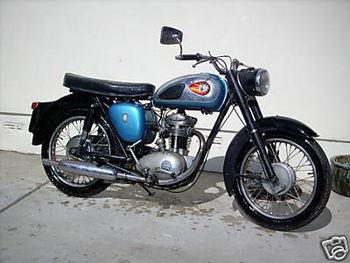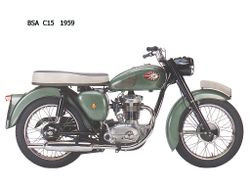Difference between revisions of "BSA C15"
| Line 1: | Line 1: | ||
[[Image:C15.jpg|thumb|350px|BSA C15]] | |||
[[BSA|BSA]] had acquired the [[Triumph|Triumph]] marque at the start of the 1950s and the lightweights towards the end of the decade owed far more to Triumph than to BSA. Chief among them was the 1952 C15 Star. A 250cc [[four-stroke|four-stroke]] almost totally derived from the 200cc [[Triumph Tiger Cub|Triumph Tiger Cub]]. Even so the new model seemed both up-to-date and sophisticated electrics. As with its Triumph predecessors, the C15 and its derivatives suffered from minor electrical problems, oil leaks and somewhat complicated maintenance routines. | |||
But it went well enough and was mainly reliable. The SS80 sports version, which appeared in 1961, was faster, while the 350 version, the [[BSA B40|BSA B40]], offered more power. In the mid 1960s a similar engine layout was seen in the 75cc Beagle and 50cc Ariel Pixie, two fatally flawed attempts by the BSA Group to launch an ultra-lightweight. | |||
Over the years there were countless variations on the same theme, including sports and off-road versions, while the basic engine was stretched to 441 and finally 449cc. The enigne even found its way back to Triumph, to power the street scrambler styled singles of the late 1960s. The last of BSA's C15 derivatives was the [[BSA B50|BSA B50]], built until 1973. Even after this, the specialist company CCM of Bolton built their own derivative of the B50 for off-road competition throughout the 1970s. | |||
Off-road sport was long a speciality of BSA. In the post-wat era the 350 and 500 Gold Stars had been enormously successful trials and scrable mounts, but the company correctly anticipated the shift towards lighter, more manageable machines. The lightweight, unit-construction C15 offered a great deal of potential and the competition shop soon developed successful works specials ridden by expert rider and BSA employee, Brian Martin. | |||
Production versions followed the C15S scrambler and C15T trials machine. Superficially similar to the roadsters there were in fact numerous differences which included frames, wheels and suspension, as well as a host of engine and gear modifications. | |||
The competition bikes succeeded famously. On the 441cc derivative, Jeff Smith won the world motocross championship in 1964 and 1965. It was the designers finest hour. | |||
==1959== | ==1959== | ||
[[Image:1959-BSA-C15.jpg|left|thumb|1959 BSA C15]] | [[Image:1959-BSA-C15.jpg|left|thumb|1959 BSA C15]] | ||
Revision as of 20:55, 20 January 2011
BSA had acquired the Triumph marque at the start of the 1950s and the lightweights towards the end of the decade owed far more to Triumph than to BSA. Chief among them was the 1952 C15 Star. A 250cc four-stroke almost totally derived from the 200cc Triumph Tiger Cub. Even so the new model seemed both up-to-date and sophisticated electrics. As with its Triumph predecessors, the C15 and its derivatives suffered from minor electrical problems, oil leaks and somewhat complicated maintenance routines.
But it went well enough and was mainly reliable. The SS80 sports version, which appeared in 1961, was faster, while the 350 version, the BSA B40, offered more power. In the mid 1960s a similar engine layout was seen in the 75cc Beagle and 50cc Ariel Pixie, two fatally flawed attempts by the BSA Group to launch an ultra-lightweight.
Over the years there were countless variations on the same theme, including sports and off-road versions, while the basic engine was stretched to 441 and finally 449cc. The enigne even found its way back to Triumph, to power the street scrambler styled singles of the late 1960s. The last of BSA's C15 derivatives was the BSA B50, built until 1973. Even after this, the specialist company CCM of Bolton built their own derivative of the B50 for off-road competition throughout the 1970s.
Off-road sport was long a speciality of BSA. In the post-wat era the 350 and 500 Gold Stars had been enormously successful trials and scrable mounts, but the company correctly anticipated the shift towards lighter, more manageable machines. The lightweight, unit-construction C15 offered a great deal of potential and the competition shop soon developed successful works specials ridden by expert rider and BSA employee, Brian Martin.
Production versions followed the C15S scrambler and C15T trials machine. Superficially similar to the roadsters there were in fact numerous differences which included frames, wheels and suspension, as well as a host of engine and gear modifications.
The competition bikes succeeded famously. On the 441cc derivative, Jeff Smith won the world motocross championship in 1964 and 1965. It was the designers finest hour.
1959

